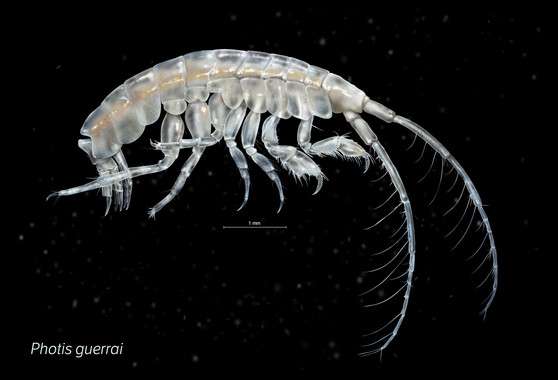Two new crustacean species discovered on Galician seabed

The seabed of the continental shelf and slope is home to rich communities of fauna. But the fauna of deep seabeds tends to be relatively unknown due to the difficulty of collecting samples at great depths. A research team from the A Graña Marine Biology Station in Galicia undertook four oceanographic expeditions in 2002, 2003, 2008 and 2009 in the waters off the northwest coast of the Iberian Peninsula.
While each of the campaigns had different objectives, they all sought to identify and categorise these benthic fauna at a depth of a thousand metres. These expeditions have led to the discovery of several new species that inhabit the abyssal plains. The researchers have now described two eyeless crustacean species of millimetric proportions. They belong to the families Photidae and Corophiidae, which they have named Photis guerrai and Pareurystheus vitucoi. Both are small, blind species measuring just a few millimetres.
"This group of crustaceans is very important in oceans, because they represent the base of the trophic chain in many marine ecosystems. Some of the most common adaptations of animal species at these depths include, among many others, the absence of vision structures and a smaller size, which enables them to withstand the high pressures," says Ramiro Rodríguez, the USC lead researcher of the study published by Zootaxa.
Deep ecosystems are very different from those found in shallower coastal waters. Sunlight does not penetrate to these depths, and as a result, there are no macroalgae. Thus, chemosynthesis is the primary biologic process. "Despite what was initially believed, however, abyssal plains are not lifeless zones. These areas are home to rich animal communities that feed on the organic material deposited gradually from the water column," says Rodríguez Tato.

These two marine animals both lack eyes. In perpetual darkness the orientation systems for many species are centred more on chemical sensory receptors than on visual organs. But because they belong to different families, the two species are very distinct. The first, a member of the Photis genus, which is very common in coastal waters, has highly characteristic lateral cephalic protrusions called cephalic lobes. It is one of the few species in this group that lacks eyes.
"Only three other of the 69 species in existence lack this visual organ," says the scientist. Furthermore, the cephalic lobes in Photis guerrai are pointed rather than rounded. The Pareurystheus genus, on the other hand, is much less common, with most members found in the waters of Japan. Pareurystheus vitucoi is the first to be recorded in the northwest Atlantic. This animal has a fifth pair of highly modified and developed thoracic appendages, unlike P. vitucoi. It is small-sized and white in colour. "It is unique in its genus, as it is the first to be described as lacking eyes," says the scientist.
However, the scientists find it hard to explain their behaviour, as it is difficult to observe these animals in situ. "They are probably detritivorous species that live on the seabed by digging galleries in which to find shelter and food, the most common method used by animals in this group that inhabits these depths," notes Rodríguez Tato.
Different types of dredges were used to collect samples, in this case three trawlers, each designed to extract a particular type of sample on a specific type of seabed. "The communities on our country's abyssal plains are not yet very well known, as these two species are just a small fraction of the results of these campaigns. I found 10 new species that I am still working on. These are just two of them," the researcher concludes.
Journal information: Zootaxa




















